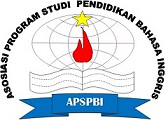GAINING ACCEPTIBILITY USING DESIGN THINKING IN FUNDAMENTAL TRANSLATION CLASS
Abstract
This paper points on the use of design thinking in fundamental translation class. Design thinking is an approach to produce the best solution of a problem. This approach includes five steps, namely empathize, define (the problem), ideate, prototype, and test. The researchers focus on the translation’s acceptability of idioms since this topic is usually problematic to students. Therefore, a case study was conducted in this research. The participants of this research were 20 students of fundamental translation class in English Literature Study Program, Universitas Jenderal Soedirman. The students translated some idioms using design thinking and their translations were randomly selected. Observation was conducted to examine the students’ behaviours in translating idioms. After that, the researchers rated their translations’ acceptability. The results indicate that design thinking’s application in translating idioms produce acceptable translations. Furthermore, this study can be beneficial for translators and translation teachers to gain acceptability in translation.
Keywords
Full Text:
PDFReferences
Creswell, J. W. (2014). Research Design_ Qualitative, Quantitative, and Mixed Method Approaches. Sage Publication Ltd.
Dam, R. F., & Teo, Y. S. (2018). 5 Stages in the Design Thinking Process. https://www.interaction-design.org/literature/article/5-stages-in-the-design-thinking-process
Grant, L. E. (2007). In a manner of speaking: Assessing frequent spoken figurative idioms to assist ESL/EFL teachers. System, 35(2), 169–181. https://doi.org/http://dx.doi.org/10.1016/j.system.2006.05.004
Kasperavičienė, R., Maumevičienė, D., & Motiejūnienė, J. (2018). Design Thinking as an Approach in Teaching Translation. INTED2018 Proceedings, 7661–7667.
Koch, C. (2016). Introduction: The HPI-Stanford Design Thinking Research Program. In L. Plattner, Hasso, Meinel, Christoph, Leifer (Ed.), Design Thinking Research: Making Design Thinking Foundational (pp. 5–12). Springer. https://www.springer.com/gp/book/9783319196404
Kwek, S. H. D. (2011). Innovation in the Classroom: Design Thinking for 21st Century Learning. Stanford University.
Leifer, L. (2016). Manifesto: Design Thinking Becomes Foundational. In L. Plattner, Hasso, Meinel, Christoph, Leifer (Ed.), Design Thinking Research: Making Design Thinking Foundational (pp. 1–4). Springer. https://www.springer.com/gp/book/9783319196404
Liedtka, J. (2015). Perspective: Linking Design Thinking with Innovation Outcomes through Cognitive Bias Reduction. Journal of Product Innovation Management, 32(6), 925–938. https://doi.org/10.1111/jpim.12163
McDonald, S. V. (2020). Accuracy, readability, and acceptability in translation. Applied Translation. https://doi.org/10.51708/apptrans.v14n2.1238
Nababan, M., Nuraeni, A., & Sumardiono, &. (2012). Pengembangan Model Penilaian Kualitas Terjemahan (Mangatur Nababan, dkk. Kajian Linguistik Dan Sastra, 24(1), 39–57.
Razzouk, R., & Shute, V. (2012). What Is Design Thinking and Why Is It Important? Review of Educational Research, 82(3), 330–348. https://doi.org/10.3102/0034654312457429
Sirkin, D. (2016). Improving Design Thinking Through Collaborative Improvisation. In L. Plattner, Hasso, Meinel, Christoph, Leifer (Ed.), Design Thinking Research Making Design Thinking Foundational (pp. 93–108). Springer. https://www.springer.com/gp/book/9783319196404
Sonalkar, N. (2016). Diagnostics for Design Thinking Teams. In L. Plattner, Hasso, Meinel, Christoph, Leifer (Ed.), Design Thinking Research Making Design Thinking Foundational (pp. 35–51). Springer. https://www.springer.com/gp/book/9783319196404
Tran, H. Q. (2012). An explorative study of idiom teaching for pre-service teachers of english. English Language Teaching, 5(12), 76–86. https://doi.org/10.5539/elt.v5n12p76
Wenzel, M. (2016). Globalized Design Thinking: Bridging the Gap Between Analog and Digital for Browser-Based Remote Collaboration. In L. Plattner, Hasso, Meinel, Christoph, Leifer (Ed.), Design Thinking Research Making Design Thinking Foundational (pp. 15–33). Springer. https://www.springer.com/gp/book/9783319196404
Willis, J. (2016). A flexible framework for task-based learning An overview of a task-based framework for language teaching. Oxford, Prabhu 1987, 52–62. http://www.willis-elt.co.uk/articles/%0Ahttp://www.intrinsicbooks.co.uk/title_by_title/framework.html
Zyzik, E. (2011). Second language idiom learning: the effects of lexical knowledge and pedagogical sequencing. Language Teaching Research, 15(4), 413–433. https://doi.org/http://dx.doi.org/10.1177/1362168811412025
DOI: http://dx.doi.org/10.20527/jetall.v5i2.12641
Article Metrics
Abstract view : 268 timesPDF - 216 times
Refbacks
- There are currently no refbacks.
This journal is indexed in:


This Journal is listed in:
 Journal of English Teaching, Applied Linguistics and Literatures (JETALL)
Journal of English Teaching, Applied Linguistics and Literatures (JETALL)








.png)



1.png)
